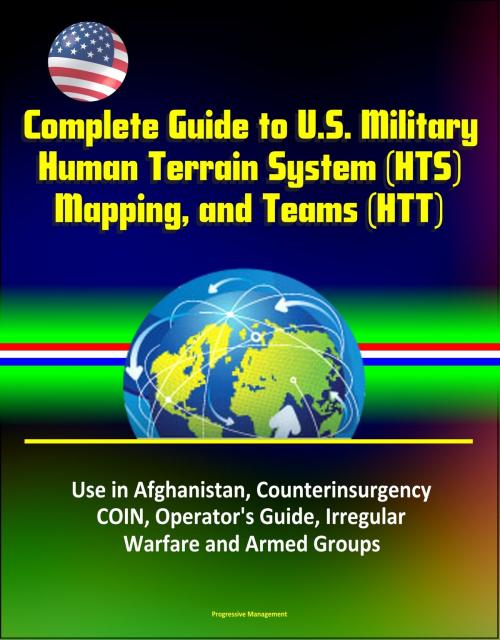Complete Guide to U.S. Military Human Terrain System (HTS), Mapping, and Teams (HTT) - Use in Afghanistan, Counterinsurgency, COIN, Operator's Guide, Irregular Warfare and Armed Groups
Nonfiction, History, Military| Author: | Progressive Management | ISBN: | 9781311287861 |
| Publisher: | Progressive Management | Publication: | April 11, 2016 |
| Imprint: | Smashwords Edition | Language: | English |
| Author: | Progressive Management |
| ISBN: | 9781311287861 |
| Publisher: | Progressive Management |
| Publication: | April 11, 2016 |
| Imprint: | Smashwords Edition |
| Language: | English |
Professionally converted for accurate flowing-text e-book format reproduction, this unique book reproduces six important military reports and studies dealing with the Human Terrain System (HTS), mapping, and teams. In the years following the invasion of Iraq, the United States military did not fully realize or understand the complexity of the situation faced by soldiers operating at the tactical and operational level. Coupled with the presence of multiple insurgent networks throughout the country, sectarian violence along ethnic and religious divides resulted in an escalation of violence. This violence forced a realization that the conflict had entered a new phase, and the military looked to classic examples of counterinsurgency (COIN). Consequently, theater strategy and doctrine development began to focus on identifying the population as the center of gravity (COG) of the COIN effort. Along with this new strategy came the requirement for a deep understanding of the Iraqi culture and the ability to conduct research and learn about the cultural aspects of the Iraqi society. This capability was found to be missing in U.S. combat formations. To address this deficiency, the Human Terrain System (HTS) was created in 2006 as a means for units to better understand and leverage culture at the operational and tactical level. Since the initiation of the program, the HTS has deployed Human Terrain Teams (HTTs) to Iraq and Afghanistan to integrate with brigades and augment existing staff structures with social science expertise. Initial reports from the field indicate the program to be largely successful. Despite reported success, the program has been the subject of much controversy, and questions remain as to whether it is the right solution for integrating cultural understanding into counterinsurgency operations. This monograph finds that although the HTS adequately fills the intended requirement by providing social science expertise down to the tactical level, it is also necessary to increase the cultural competence of the entire force. Additionally, the Army must bolster organic capabilities of tactical formations in order to be prepared for the unexpected challenges of the future.
Documents in the collection:
Human Terrain Mapping and Its Application for Counterinsurgency Operations in Afghanistan
Lost In Translation: The Importance Of Retaining Army Sociocultural Capabilities In An Era Of Persistent Conflict
Quantifying Human Terrain
Cultural Understanding in Counterinsurgency: Analysis of the Human Terrain System
Mapping the Human Terrain in Afghanistan
An Operator's Guide to Human Terrain Teams - CIWAG Case Study on Irregular Warfare and Armed Groups - The ultimate goal in creating HTS was to supplement military and civilian efforts in Iraq and Afghanistan by providing a subject matter capability and helping to interpret social grievances and the role they play in conflict. By identifying the factors leading to violence, Human Terrain Teams (HTT) help field operators, commanders, and policy officials better understand the civilian population. Each program assists with strategy implementation, consensus building, and casualty reduction. Secondary efforts focus on leveraging community resources and gradually reducing US and NATO expenditures - measures that will help achieve the end goal of Afghan self-sufficiency. Further, HTS's capability is aimed at helping military and civilian leadership map out a nexus of second- and third-order effects, an activity that will ultimately increase operational efficiency and maintain combat strength. Sections I and II of this case study explore how HTT advisors can aid operators and military/civilian leadership in the irregular warfare battle-space. The sections begin with a community profile that identifies the social, cultural, economic, and political issues affecting a specific local environment.
Professionally converted for accurate flowing-text e-book format reproduction, this unique book reproduces six important military reports and studies dealing with the Human Terrain System (HTS), mapping, and teams. In the years following the invasion of Iraq, the United States military did not fully realize or understand the complexity of the situation faced by soldiers operating at the tactical and operational level. Coupled with the presence of multiple insurgent networks throughout the country, sectarian violence along ethnic and religious divides resulted in an escalation of violence. This violence forced a realization that the conflict had entered a new phase, and the military looked to classic examples of counterinsurgency (COIN). Consequently, theater strategy and doctrine development began to focus on identifying the population as the center of gravity (COG) of the COIN effort. Along with this new strategy came the requirement for a deep understanding of the Iraqi culture and the ability to conduct research and learn about the cultural aspects of the Iraqi society. This capability was found to be missing in U.S. combat formations. To address this deficiency, the Human Terrain System (HTS) was created in 2006 as a means for units to better understand and leverage culture at the operational and tactical level. Since the initiation of the program, the HTS has deployed Human Terrain Teams (HTTs) to Iraq and Afghanistan to integrate with brigades and augment existing staff structures with social science expertise. Initial reports from the field indicate the program to be largely successful. Despite reported success, the program has been the subject of much controversy, and questions remain as to whether it is the right solution for integrating cultural understanding into counterinsurgency operations. This monograph finds that although the HTS adequately fills the intended requirement by providing social science expertise down to the tactical level, it is also necessary to increase the cultural competence of the entire force. Additionally, the Army must bolster organic capabilities of tactical formations in order to be prepared for the unexpected challenges of the future.
Documents in the collection:
Human Terrain Mapping and Its Application for Counterinsurgency Operations in Afghanistan
Lost In Translation: The Importance Of Retaining Army Sociocultural Capabilities In An Era Of Persistent Conflict
Quantifying Human Terrain
Cultural Understanding in Counterinsurgency: Analysis of the Human Terrain System
Mapping the Human Terrain in Afghanistan
An Operator's Guide to Human Terrain Teams - CIWAG Case Study on Irregular Warfare and Armed Groups - The ultimate goal in creating HTS was to supplement military and civilian efforts in Iraq and Afghanistan by providing a subject matter capability and helping to interpret social grievances and the role they play in conflict. By identifying the factors leading to violence, Human Terrain Teams (HTT) help field operators, commanders, and policy officials better understand the civilian population. Each program assists with strategy implementation, consensus building, and casualty reduction. Secondary efforts focus on leveraging community resources and gradually reducing US and NATO expenditures - measures that will help achieve the end goal of Afghan self-sufficiency. Further, HTS's capability is aimed at helping military and civilian leadership map out a nexus of second- and third-order effects, an activity that will ultimately increase operational efficiency and maintain combat strength. Sections I and II of this case study explore how HTT advisors can aid operators and military/civilian leadership in the irregular warfare battle-space. The sections begin with a community profile that identifies the social, cultural, economic, and political issues affecting a specific local environment.















